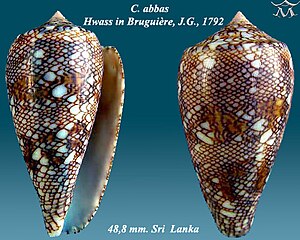Conus abbas
| Conus abbas | ||||||||||||
|---|---|---|---|---|---|---|---|---|---|---|---|---|

Conus abbas , Sri Lanka |
||||||||||||
| Systematics | ||||||||||||
|
||||||||||||
| Scientific name | ||||||||||||
| Conus abbas | ||||||||||||
| Hwass in Bruguière , 1792 |
Conus abbas is a sea snail that occurs in the Indian Ocean between East Africa and India and in the Pacific Ocean off the Philippines and off Java ( Indonesia ). Like all members of the genus Conus , Conus abbas is a predatory snail whose radula teeth are connected to a venom gland .
description
The height of the case varies and is between 38 mm and 64 mm. Slight reticulated furrows can be seen on the shell. The color of the shell is white and has thin orange-brown bands. In rare cases, chocolate-colored stripes running vertically from the bottom to the top can also appear. Conus abbas is similar to the Weber cone ( Conus textile ).
The thin, translucent, smooth periostracum is yellowish-brown.
The foot is pale orange-yellow and sparsely spotted brown, on the front orange-pink. The sipho is white, merging distally into red, with a fairly wide black ring in the middle.
Since Conus abbas can also be poisonous for humans, living specimens should be treated with great care.
distribution and habitat
Conus abbas is widespread in the Indian Ocean on the coasts of East Africa , southern India and Sri Lanka , off the Indonesian islands of Java and Bali and in the Pacific Ocean on the Philippines .
It lives in shallow water to a depth of about 50 m on coral reefs, often under coral rocks.
Lifestyle and diet
The development cycle of Conus abbas is still unknown. The diet and the range of prey of Conus abbas have not yet been described. According to the system of JK Tucker and MJ Tenorio (2009), Conus spectrum belongs to the genus Cylinder , which is a subgenus of Conus after the revision by N. Puillandre, TF Duda, C. Meyer, BM Olivera and P. Bouchet (2015) . Other cone snails of this sub-genus prey on snails, which they immobilize by repeatedly stabbing their poisonous teeth , so that this is also assumed for Conus abbas .
Danger
The IUCN classifies Conus abbas as not endangered (least concern), as this cone snail is rare, but occupies a very large area in the Pacific Ocean.
literature
- George Washington Tryon: Manual of Conchology, structural and systematic, with illustrations of the species , vol. VI; Academy of Natural Sciences, Philadelphia 1884. C [onus] abbas Hwass., P. 92.
- Dieter Röckel, Werner Korn, Alan J. Kohn: Manual of the Living Conidae Vol. 1: Indo-Pacific Region . Verlag Christa Hemmen, Wiesbaden 1995. The texts on the individual cone snail species of the Indo-Pacific are published on The Conus Biodiversity website with the permission of the authors (see web links).
Individual evidence
- ↑ JK Tucker, MJ Tenorio (2009): Systematic Classification of Recent and Fossil Conoidean Gastropods. ConchBooks, Hankenheim 2009.
- ↑ N. Puillandre, TF Duda, C. Meyer, BM Olivera, P. Bouchet (2015): One, four or 100 genera? A new classification of the cone snails. Journal of Molluscan Studies 81, pp. 1-23.
- ↑ Conus abbas in the endangered Red List species the IUCN 2013. Posted by: A. Kohn, 2011. Retrieved on February 22 2016th
Web links
- The Conus Biodiversity Website: Conus abbas Hwass in Bruguière, 1792.
- P. Bouchet: Conus abbas Hwass in Bruguière, 1792 In: MolluscaBase, 2015, retrieved from the World Register of Marine Species (WoRMS) on February 22, 2016
- Cone Shells - Knights of the Sea
- Gastropods.com: Pionoconus aurisiacus